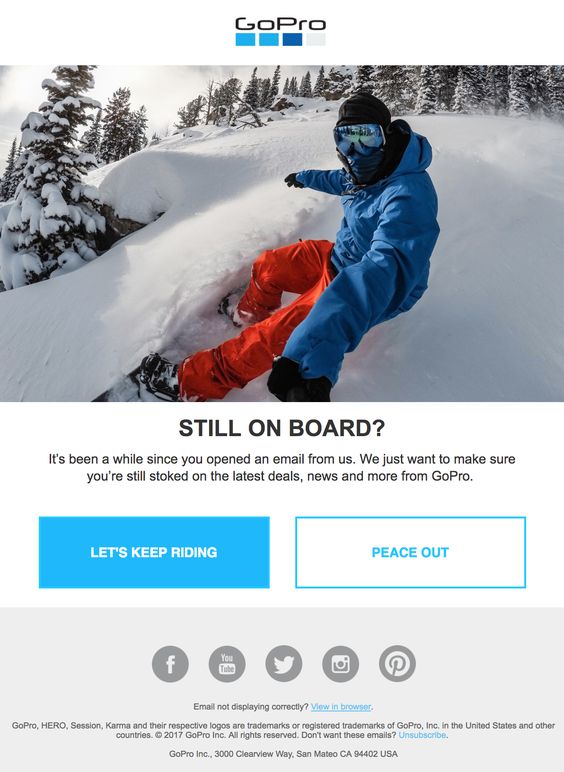We’ve covered the basics of customer reactivation (click the link for a refresh). Now, let’s dig deeper. The following tips and tricks help you create high-response surveys and effective win-back email campaigns, setting you on the road to success. Just need to target a few lost clients? Don’t have a strong email list? Play to your strengths with our tips for phone calls, personal emails and postcards, too.
Creating a winning survey
First, you always want to pinpoint what constitutes an inactive customer. A personal trainer might start the reactivation process after a month of inactivity, but an e-commerce shop might wait three months.
Next, you need to determine where the relationship went off the rails. A customer database and analytics provide a lot of info you need. Surveys, on the other hand, give you answers straight from the inactive customers.
Create a short list of questions. Cover what made the customer choose your company, why they haven’t been back and who, if anyone, they chose in your place. If you have a good idea why customers aren’t coming back, multiple choice questions keep things simple, but always leave an “other” option for written comments. When you can’t spot a common theme in your data, open-ended questions may be best.
Tell customers the purpose of the survey. Phrases like “We want to improve” and “Help us do better” let customers know that you’re looking for feedback—not personal data—and encourages honest responses.
Keep the survey succinct. Statistically, 45% of people will spend five minutes on a feedback survey and 33% will spend up to 10 minutes. Anything longer results in incomplete or inaccurate responses and a lower response rate.
Use skip logic to avoid asking questions that aren’t relevant. For example, if an inactive customer says they haven’t found another company to replace you, asking them why they decided to go with another company doesn’t make sense. When a customer answers “no” to finding another company, the survey will automatically skip any questions asking about your competitor.

Crafting a persuasive win-back email campaign
Platforms like MailChimp, Zoho or Constant Contact let you set up a series of emails specifically for winning back inactive customers. Your business model and brand voice dictate the emails you send, when they go out and how they’re spaced, but a reactivation campaign typically includes a series of emails spaced five to seven days apart.
There are multiple “types,” but here are some of the most common:
- The “miss you” email. This puts your company back on the customer’s radar. Keep it short and sweet, highlighting new products or services you’ve launched since the customer last shopped or worked with you; or, emphasizing the value you bring to active customers. Throwing in an incentive, like a discount or free shipping, doesn’t hurt.
- The discount email. Give customers a bigger reason to come back with a discount that’s a slightly better deal than the one you included in the initial email (if you included one); or, wait to send the discount to only the customers who opened the first “miss you” email. Keep the discount expiration short to encourage immediate action.
- The reminder email. Remind the customer of the discount 24 to 48 hours before it expires.
- The extension email. If the customer opened the initial email offering a discount, but didn’t use it, consider extending the deal by one to two days.
- The opt-out email. Invite the customer to discontinue receiving emails if they haven’t opened the first round of emails or if they failed to act on a discount despite a reminder and extension. Remember, your email list is only effective if the people you’re reaching out to are engaged; if they’re not, there’s no point in keeping them on the list.

Be strategic with subject lines. “Miss you,” “come back” and the exact discount amount offered have the highest open rates.
Amplify your efforts with email retargeting ads. These display and social media ads show up to anyone who’s opened an email with a retargeting pixel, or on the social media accounts associated with a list of emails you provide to the social media platform. These ads should focus on content, upcoming events or new products, and serve to keep your company fresh in the customer’s mind.
Reactivating when mass campaigns don’t cut it
If you’re a freelancer who wants to try to re-engage a handful of wayward clients, you’re working with a skimpy email list or you think a more personal, less “techy,” touch will most engage your past customers, there are other options: phone calls, personal emails and postcards.
Phone calls
Pick up the phone and call past clients for a friendly chat. Because you’ve worked with these clients one-on-one, any mass reactivation campaign falls flat.
Keep the conversation casual—it’s off-putting to have someone call you and read through an obvious survey.
Bring up any personal connection you have before segueing into the purpose of the call. Both basketball fans? Talk March Madness or the upcoming draft.
Don’t be afraid to be blunt. The world’s best salesperson manipulates a conversation to get the information they want, but even the slightest misstep ruins your chances at winning the client back. Instead, let him or her know that you enjoyed working with them, are trying to refine your services and could use some feedback on what you can do better.
Direct emails
Click that compose button and write a personal email to each client. A friendly touching-base email that includes a personal anecdote and shows a desire to catch up gives you a foot in the door for a more in-depth exchange.
Don’t send more than one follow-up email if you get radio silence after the first email and initial follow-up.
Avoid flashy HTML and loads of graphics. You need to capitalize on the relationship you developed with the client, and something that looks like a marketing email won’t do the trick.
Postcards
Use the mailing addresses you have at your disposal and send out “miss you” discount postcards. If you haven’t kept up with your customer database or aren’t confident in your email lists’ accuracy, but you do have mailing addresses, postcards can lure even the most lapsed customer back in.

Moving forward: be proactive
Reactivation doesn’t stop after the last email you send, phone call you make or postcard you mail out.
You now have a good idea why some customers left—so fix it. If too-long shipping or turnaround times were a common theme, find ways to shorten your handling time or project delivery timelines. Did a competitor whisk customers away with lower prices for a similar-quality product or service? Improve your product or service, focus on marketing how you outperform competitors or find a way to drop the price.
Not all businesses fit all customers, so don’t expect to win back everyone on your list. But with a little wooing, they just might give you another chance.




